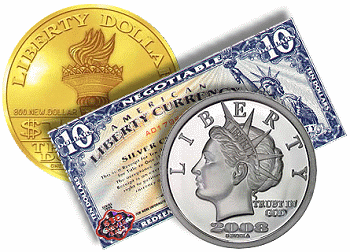Bernard von NotHaus of Liberty Dollar Has His Motion for Post-Conviction Relief Denied, Will Face Sentencing
Back in 2009, after a raid on his businesses in 2007, Bernard von NotHaus, the man behind the Liberty Dollar, was arrested and charged with various crimes connected to counterfeiting. He was convicted in federal court in North Carolina in 2011, but has still not been sentenced.

As I wrote in 2011:
His conviction was based on the premise that a minted round of nearly pure silver that is neither the same size nor denomination as any existing U.S. coin and does not display identical imagery is nonetheless a counterfeit of U.S. currency. In a press release announcing the conviction, U.S. Attorney Anne Tompkins described the Liberty Dollar as a form of "domestic terrorism."
Von NotHaus, who once ran an organization called the National Organization for the Repeal of the Federal Reserve and Internal Revenue Codes, explicitly advertised his silver product as competition to federal fiat money. He called the Liberty Dollar a "voluntary private barter currency," a phrase that appeared on the coins in later mintings.
See this from 2012 for many of the details of the convoluted case, and this on the original raids on Liberty Dollar.
This week, a long-simmering motion to have his conviction overturned was denied by U.S. District Judge Richard Vorhees.
Summation and excerpts from Vorhees' order:
these post-conviction filings present a question as to the scope and extent of Congress's constitutional power to coin money and regulate its value whether Congress, under the Constitution and by enactment of 18 U.S.C. § 486 and its prohibition of coins "intended for use as current money," has the power to coin money to the exclusion of all others, including individuals like Defendant von Nothaus…..
After presenting a series of what he sees as precedent decisions in support of his conclusion, Vorhees writes:
the undersigned is of the opinion, and this Court so finds as a matter of law, that Congress indeed possesses the power to criminalize an individual's minting of coinage, whether in resemblance of U.S. coins or of original design, that is intended for use as current money.
Von NotHaus had more arguments:
Defendant contends that in order to be "current," the U.S. money with which the Liberty Dollar is accused of seeking to compete must be genuine items of U.S. currency presently in circulation and of the same denomination…..
According to the defense, because the United States does not mint silver coins in denominations of $5, $10, $20, and $50, the values of the accused Liberty Dollar pieces, the conviction under § 486 must be vacated. The undersigned declines to construe the phrase "intended for use as current money" as narrowly as the defense proposes…..
the Court construes 18 U.S.C. § 486 such that, regardless of the nature of the subject coin (in resemblance or of original design), if a coin is "intended for use as current money" then there must necessarily be a deceptive quality about its design. In other words, resemblance and original design, while capable of independent existence, are not necessarily mutually exclusive under a plain reading of the statute.
The rest of Vorhees' opinion knocks down von NotHaus' claims of insufficient evidence of criminal intent, that the jury was given improper instructions on the extent of the government's exclusive power to coin money, and that some of the evidence against him given by federal agents should be considered inadmissable hearsay.
As noted in this Coinweek story on the case, von NotHaus is scheduled to finally receive sentencing in this case on December 2, reminding readers that the 70-year-old man has been awaiting sentence for over 3 and a half years now.
